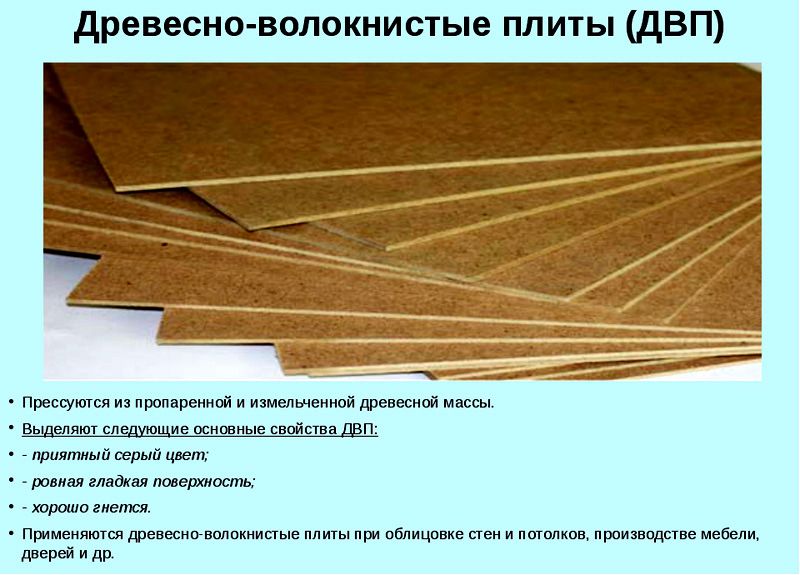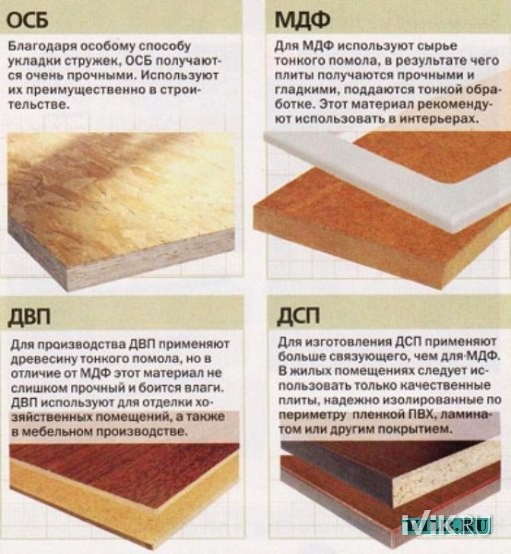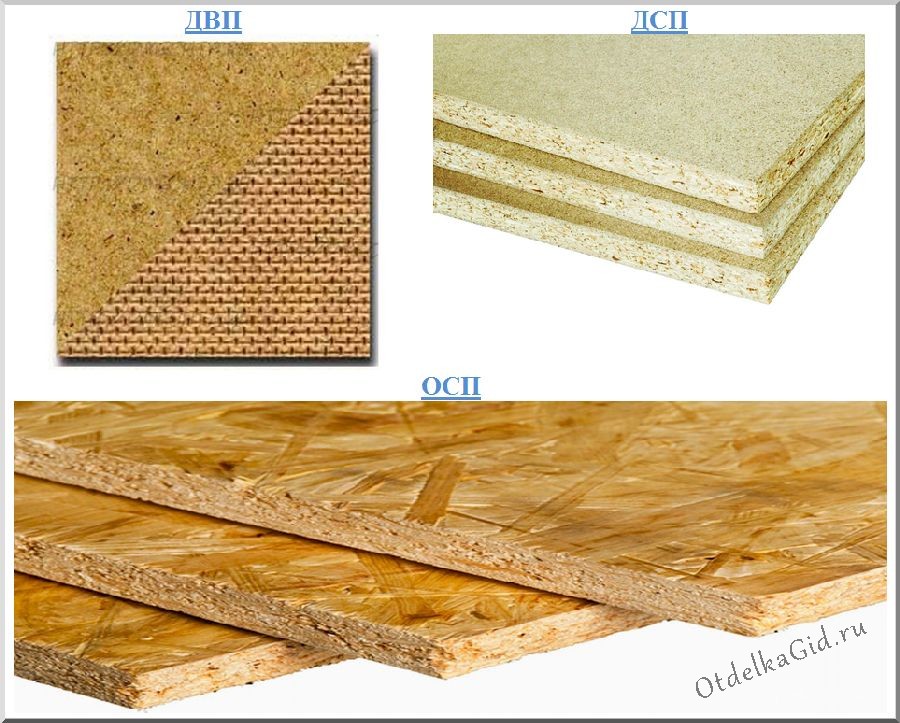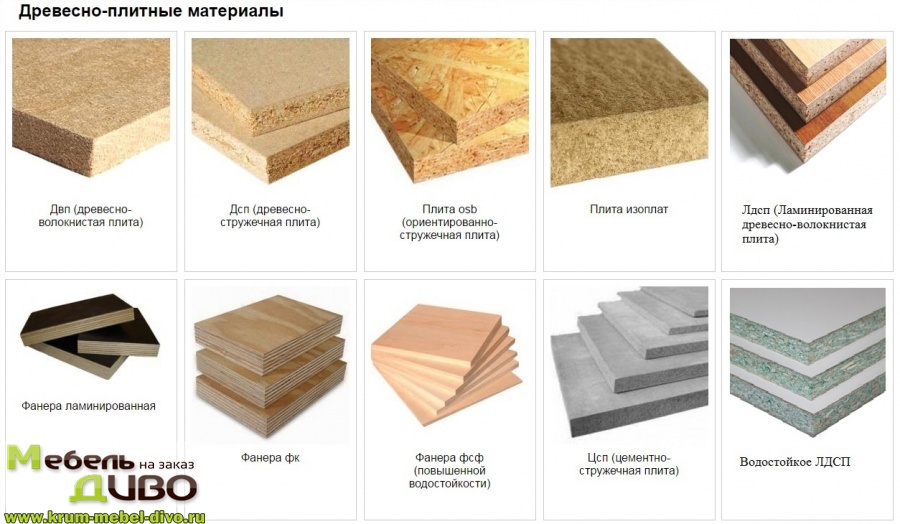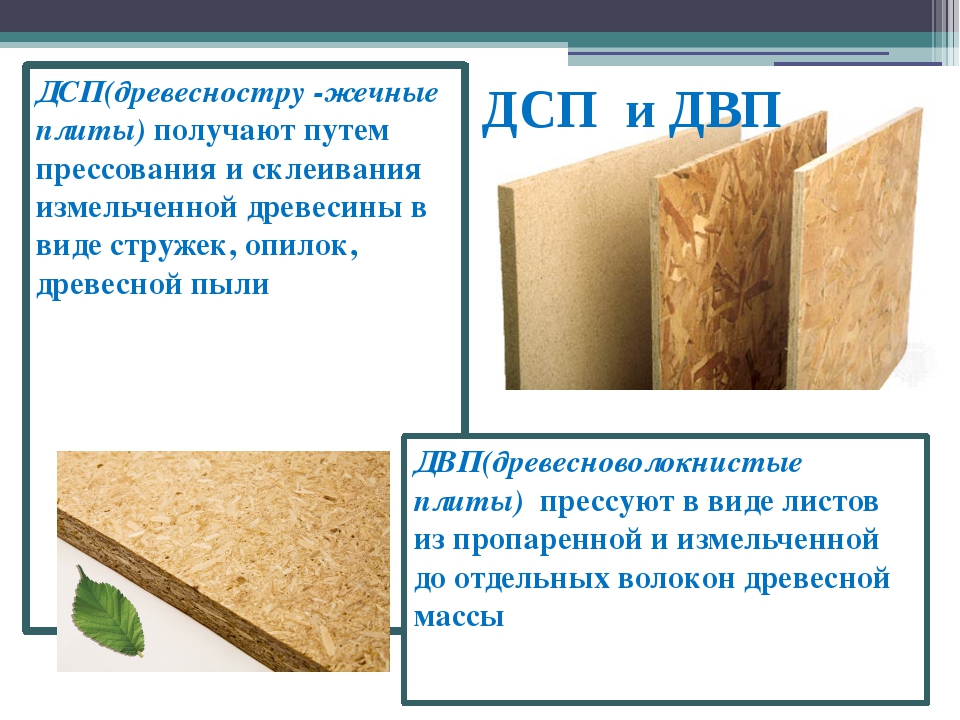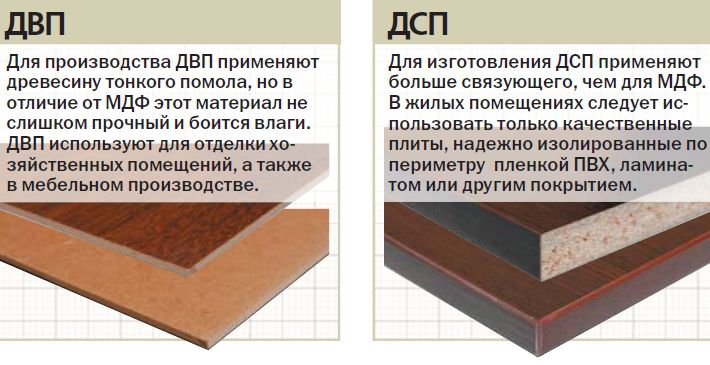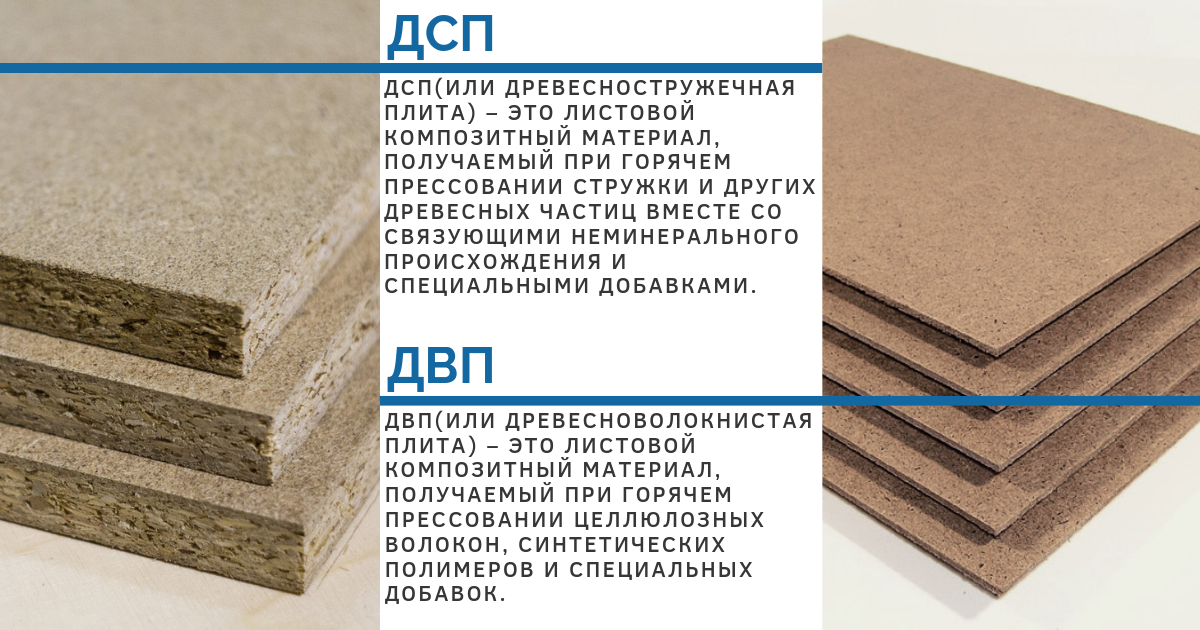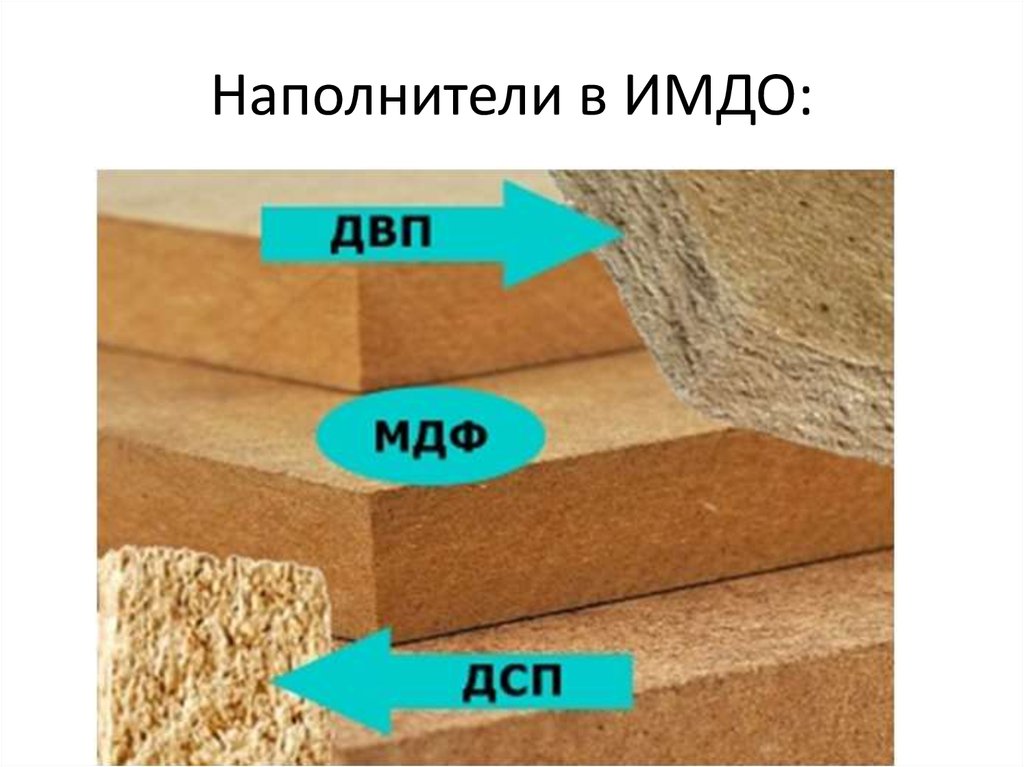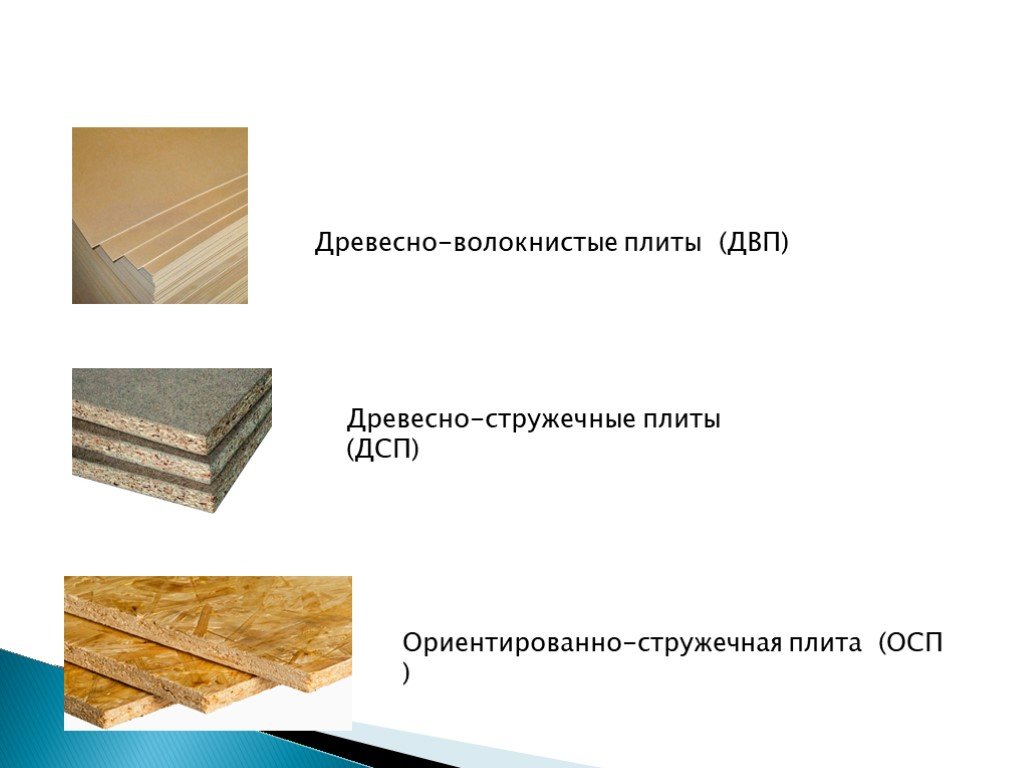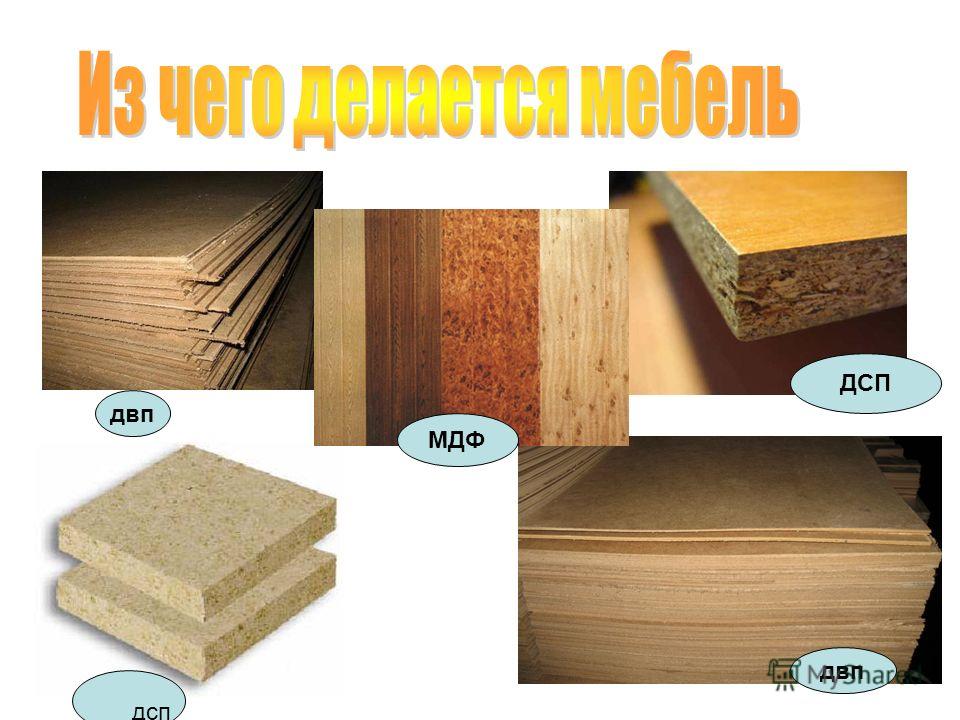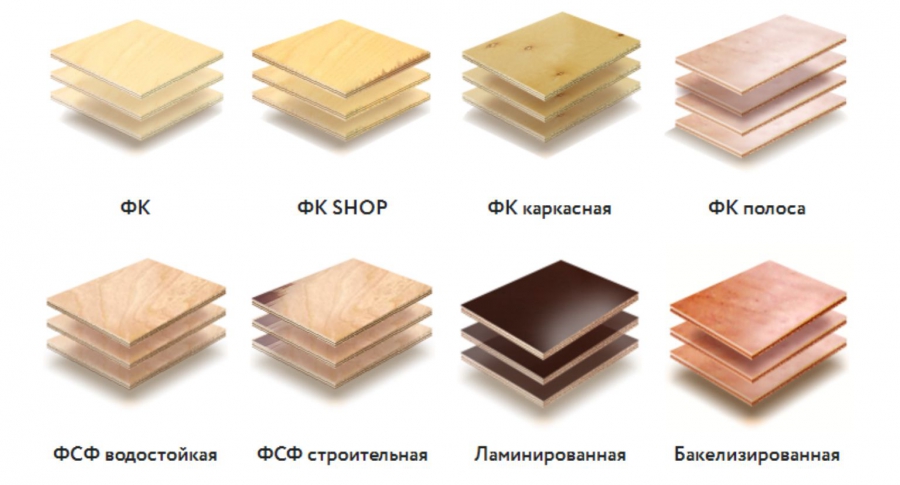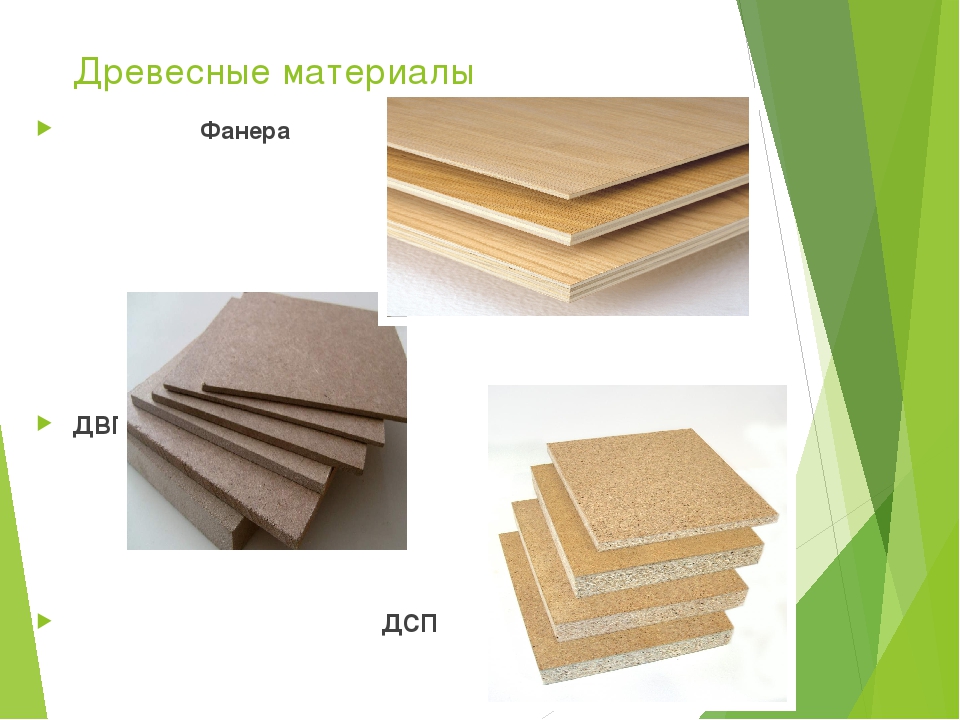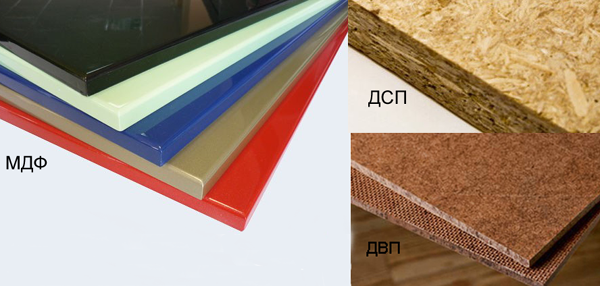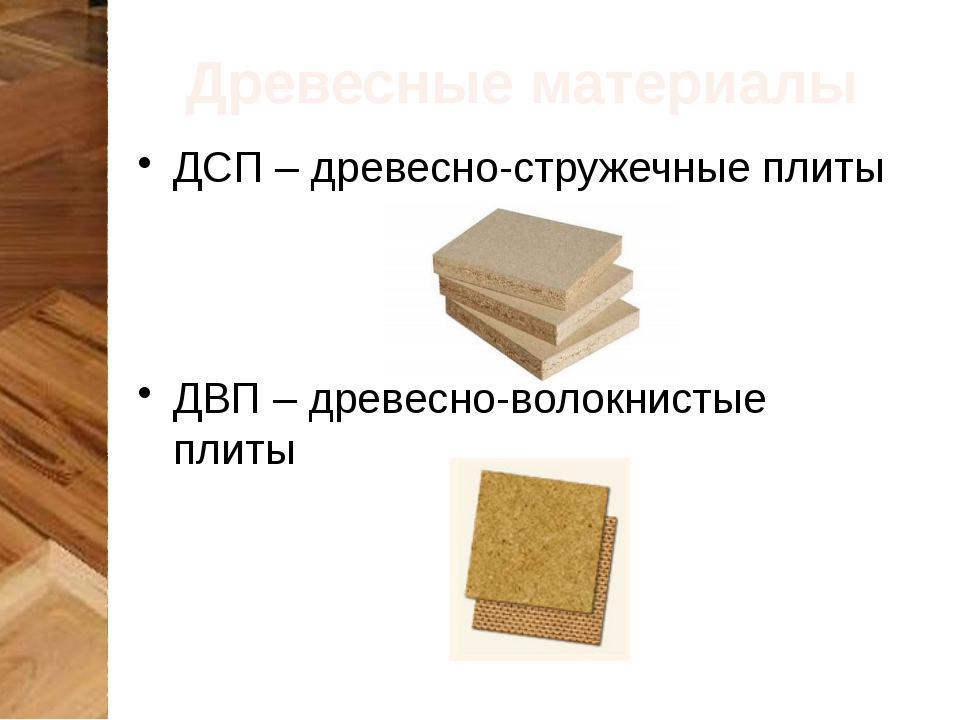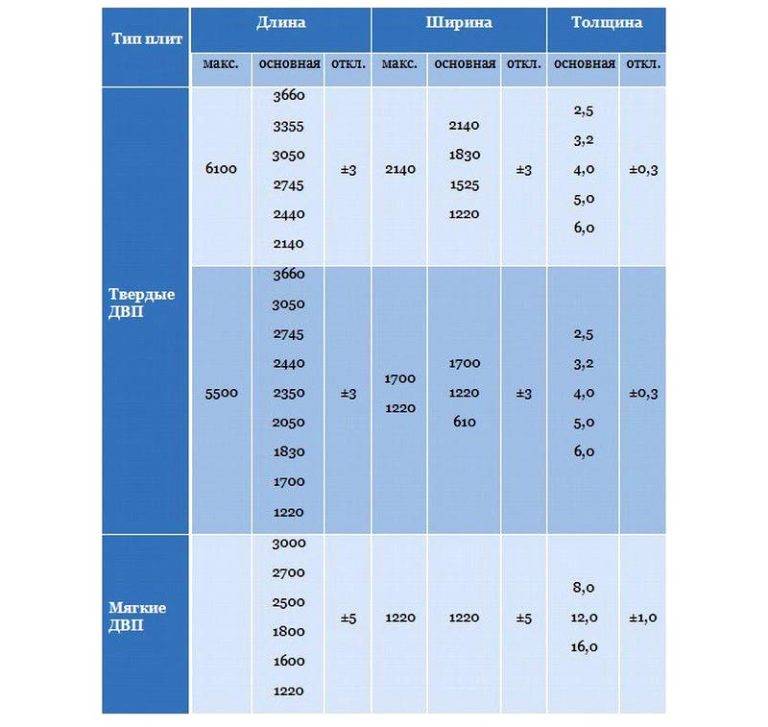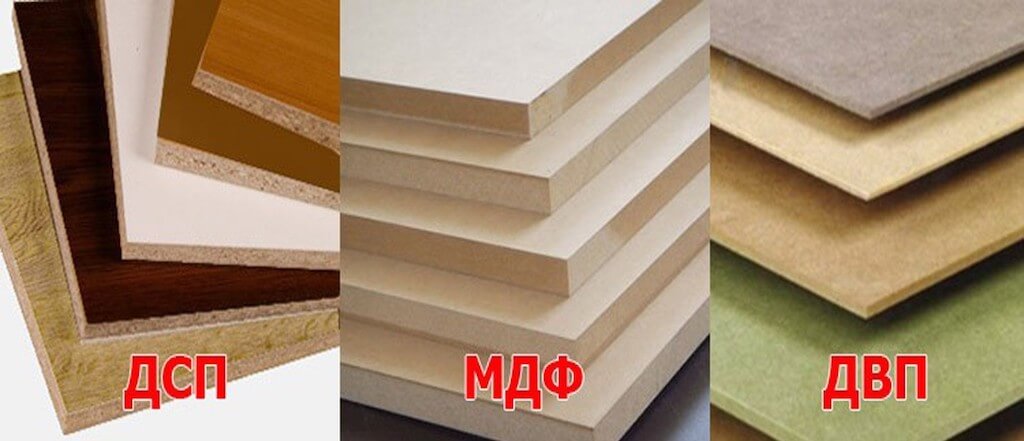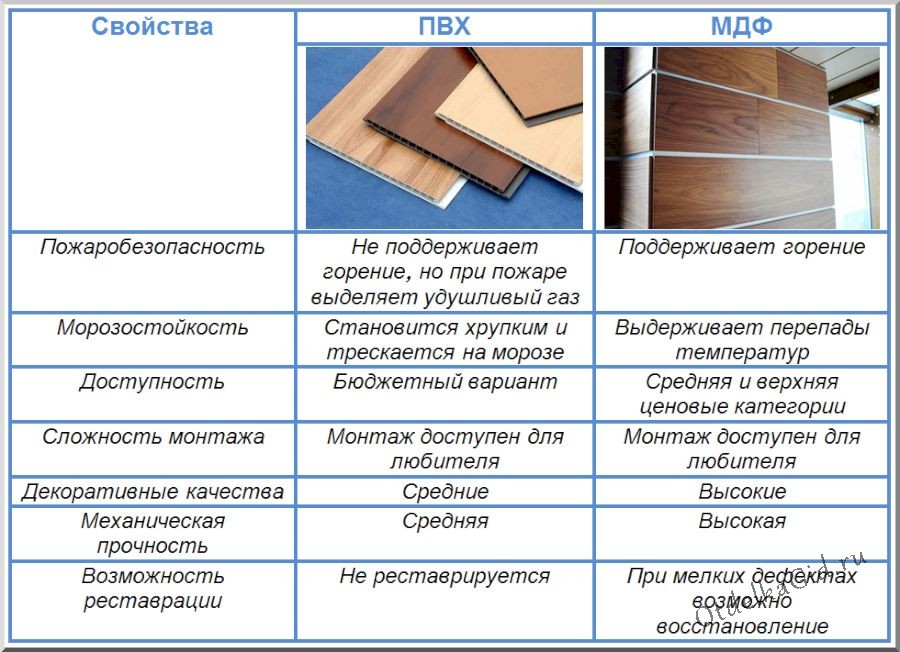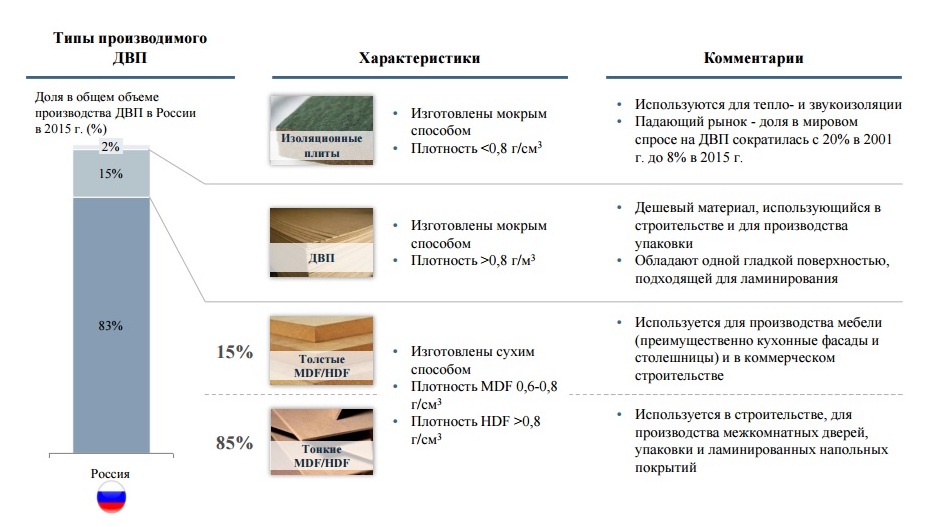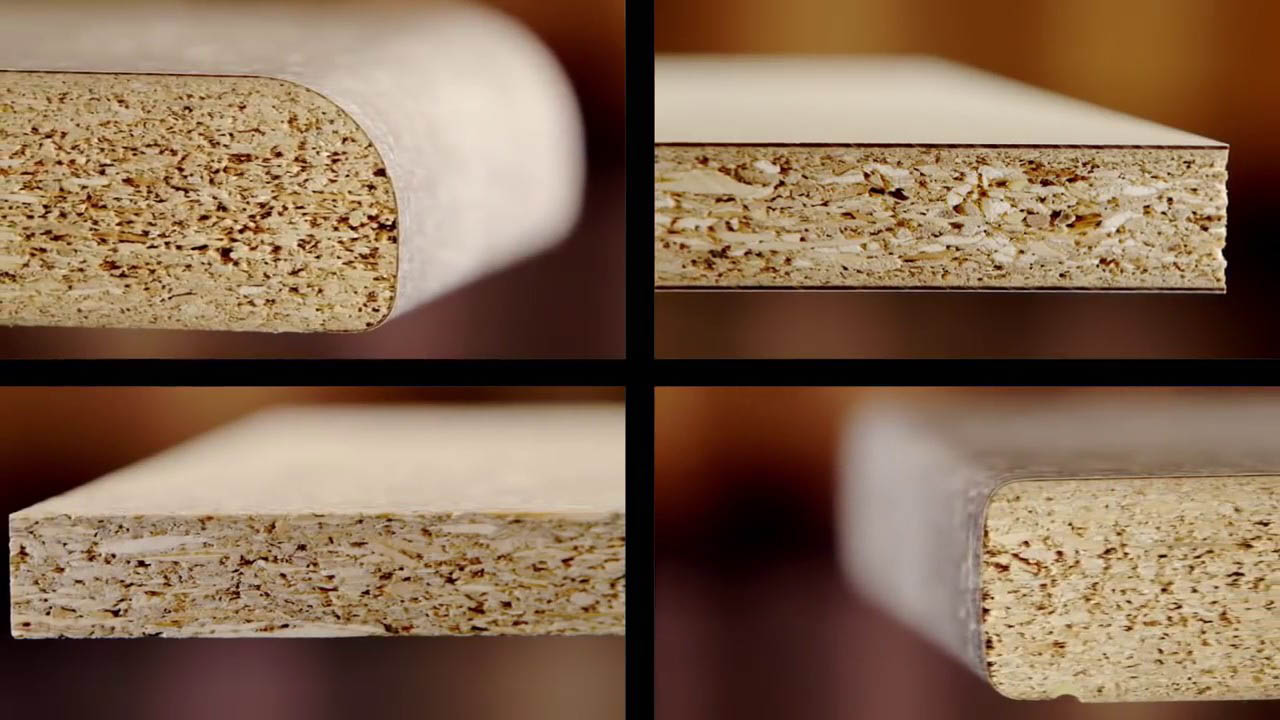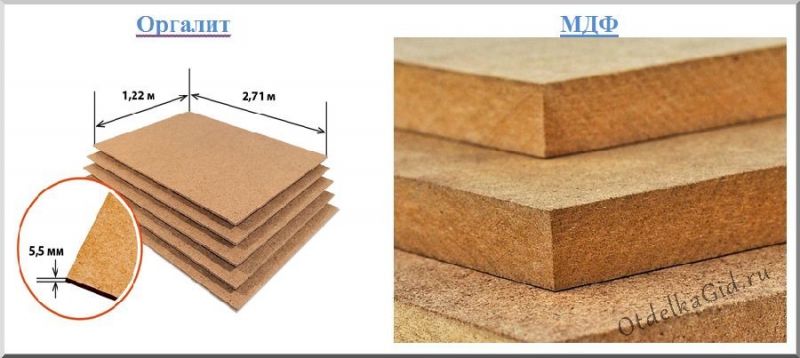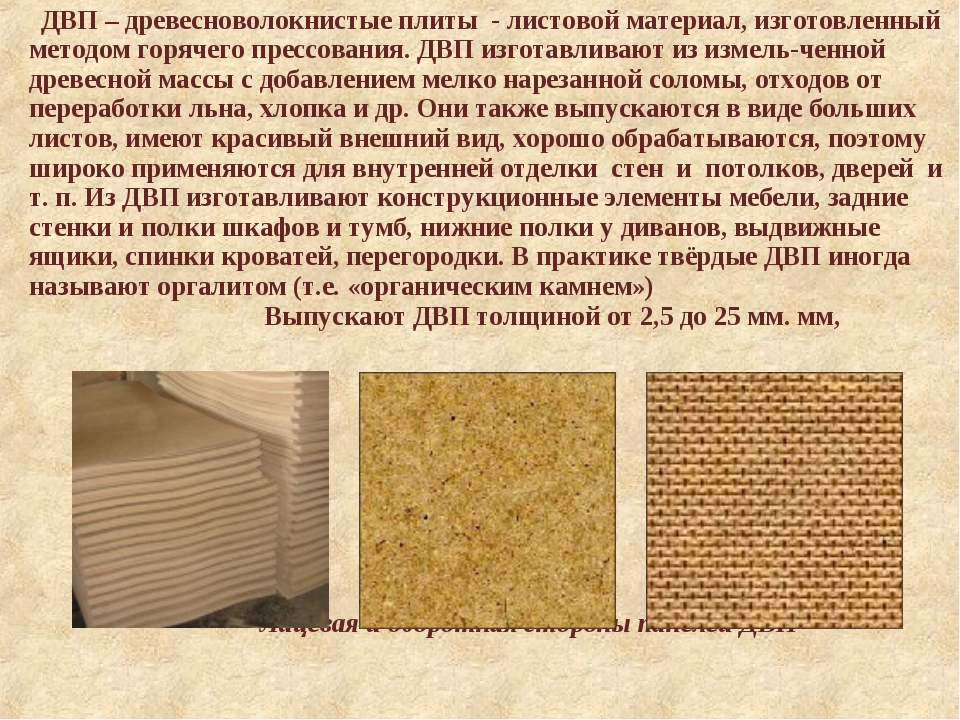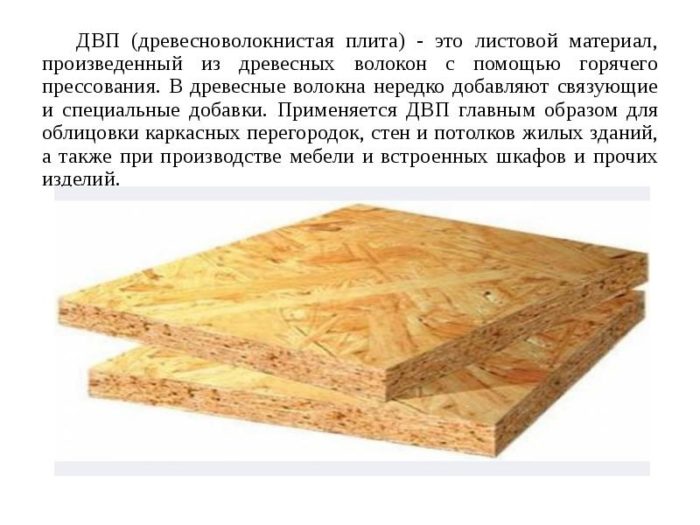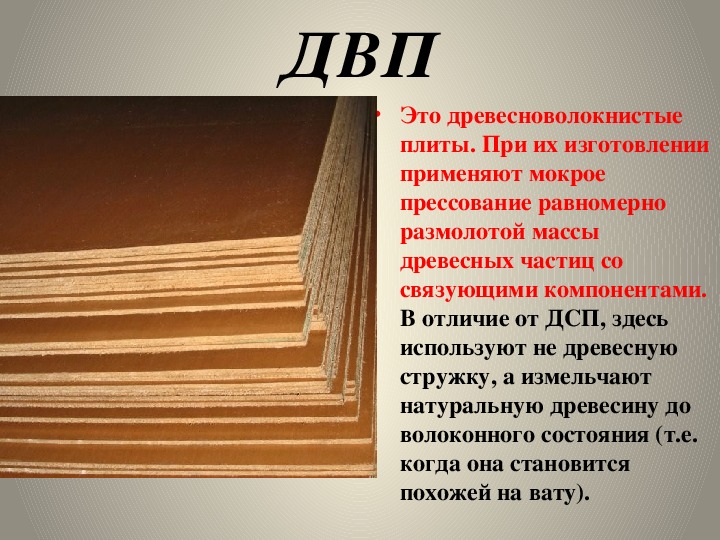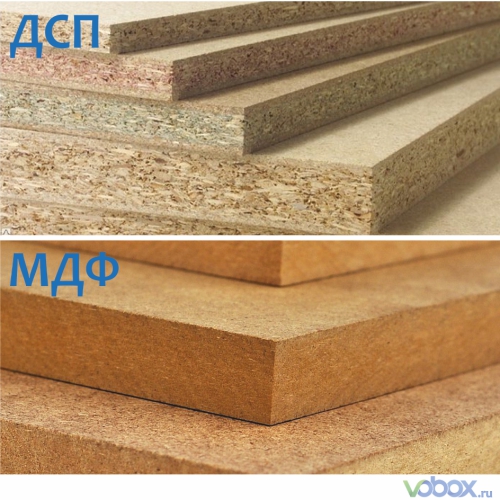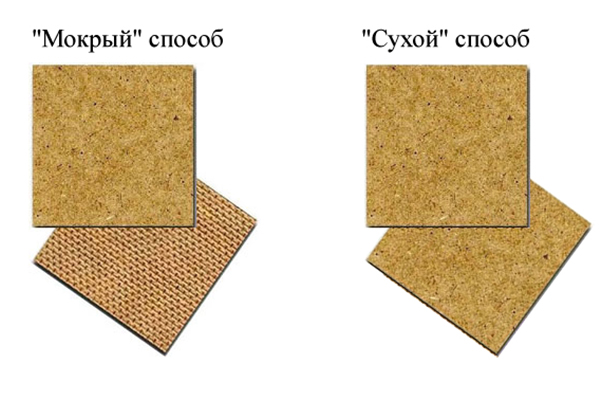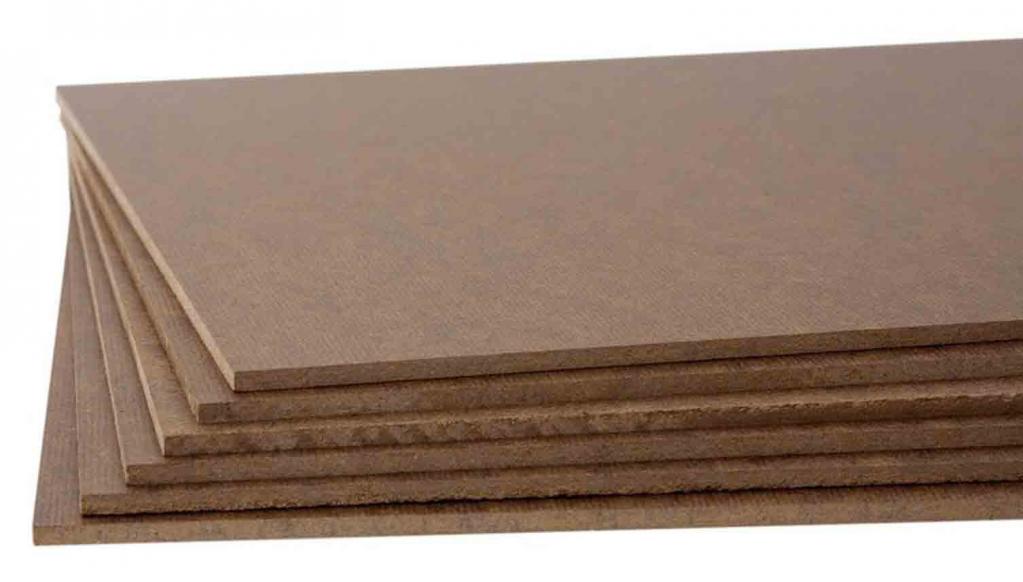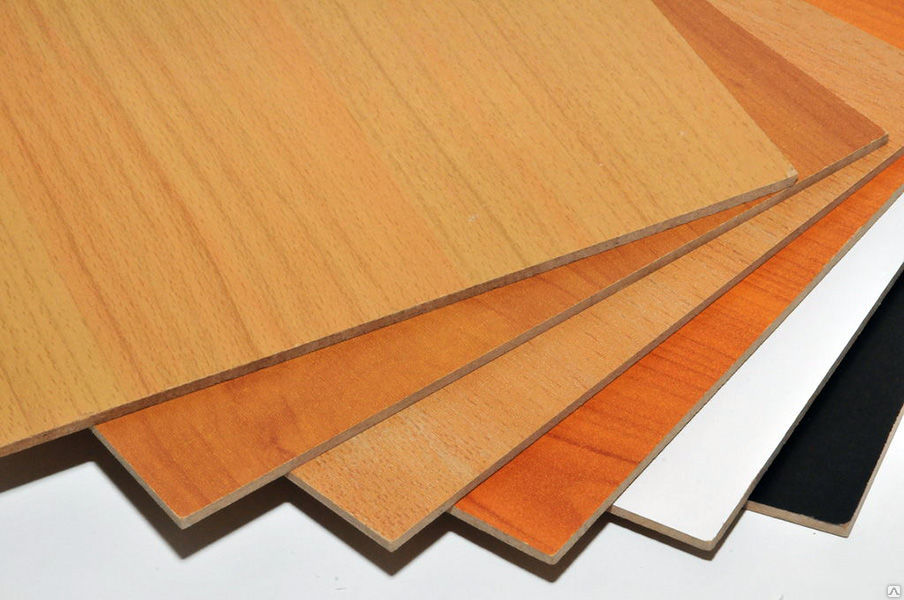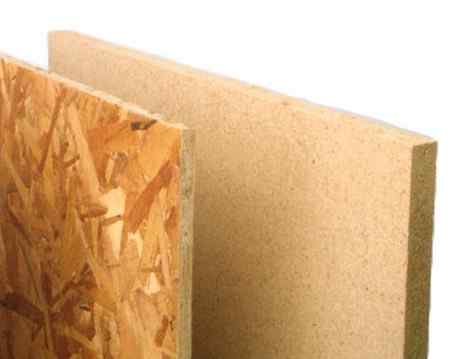Production
Chipboard, as the name implies, is created on the basis of a coarse fraction of wood chips. The source of raw materials for production is substandard wood, chips and sawdust.
 Chipboard machine
Chipboard machine
The production process proceeds as follows: crushed raw materials are dried and moistened through nozzles with binding components. As a binder, synthetic urea, phenolic or urea melamine resins are used.
Comparison of the thickness of fiberboard and chipboard
The processed mixture of shavings and resins can be molded:
- single-layer, when chips of different fractions are mixed and evenly distributed throughout the plate;
- from two layers, when the underlying layer is made of waste, and the front layer is a mixture of fine and wide shavings specially sorted on a separator;
- from two face layers made of selected raw materials and a core that uses less quality waste.
The formed particle carpet is sent for pressing, drying, board trimming and end grinding.
As a finish, especially if the chipboard is planned to be sent to decorative cladding in the future, grinding of the entire surface can be additionally used.
Unlike chipboard, fiberboard materials require two additional stages of mechanical processing after splitting the raw material into chips:
- initial coarse grinding on defibrators;
- finer grinding on refiners.
As a result, the wood is separated into individual fibers. Such a macro-processed pulp is the basis of hardboard, and even when creating it, hemp of a fire, waste of flax production, and waste paper can be used. The mass compiled according to the recipe is sent for further processing to tanks, in which it is soaked in a water mixture of hardening additives and glued with water-repellent substances.
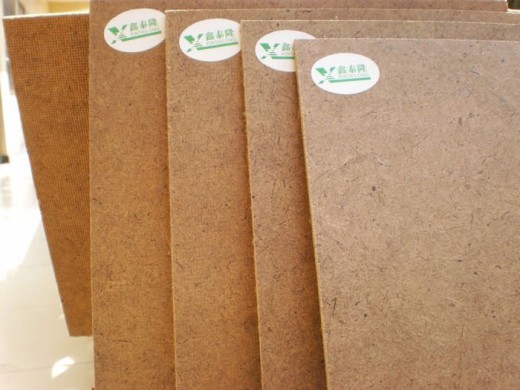 Fiberboard is the back walls of furniture, a material for finishing the floor, mill and ceiling of houses and outbuildings
Fiberboard is the back walls of furniture, a material for finishing the floor, mill and ceiling of houses and outbuildings
The mixture prepared in this way enters the casting machines, after which it passes the stage of thermal pressing at a temperature of 210-230 ° C and a maintained pressure of 3-5 MPa.
Comparison of materials
To determine the difference between the slabs, there are a number of factors to consider:
- Environmental friendliness. It is believed that only wood-fiber products can be used for the production of furniture, since they are environmentally friendly. In fact, all varieties produced in large quantities contain some percentage of toxic binder resins, but their concentration does not exceed the norm.
- Wear resistance. Determining the most durable material is not always easy, since all varieties tolerate mechanical loads well, but they deform under a point effect.
- Resistant to moisture. If we compare MDF and laminated chipboard by this parameter, the first option will turn out to be the undisputed favorite. It is from medium density slabs that furniture for bathrooms and shower rooms is produced. But properly processed laminated chipboard parts are also able to withstand fluctuations in humidity.
 The quality of MDF panels is certainly higher, but in furniture sets, these characteristics are not always in demand, especially when it comes to dry heated rooms, so the sales of laminated chipboard and MDF are on the same level
The quality of MDF panels is certainly higher, but in furniture sets, these characteristics are not always in demand, especially when it comes to dry heated rooms, so the sales of laminated chipboard and MDF are on the same level
The negative attitude towards products made of laminated chipboard arises due to the fact that low quality products are present in large volumes on the furniture market. Basically, it is produced in private workshops, where low density slabs are used to reduce the cost of production and fittings are distributed without regard to technology.
Using sheet wood materials for home insulation
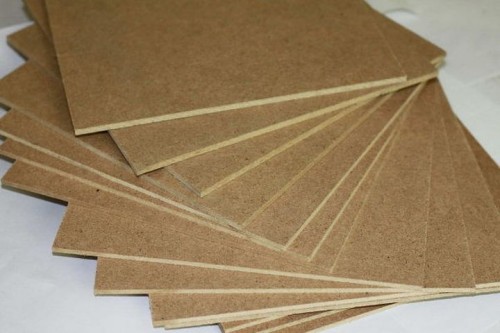
One of the most popular areas of use for chipboard and fiberboard sheets is floor insulation and leveling.
The concrete floor is cold and uncomfortable. This is especially noticeable in winter on the first floor of the house. In such a situation, even warm slippers do not help. You can't lie on the concrete floor or play with children and pets. That is why, before laying the finishing coat for the floor, be it linoleum, laminate or parquet, the floors are leveled and at the same time insulated by laying chipboard. This simple procedure allows you to achieve a perfectly flat surface and provides warmth and comfort.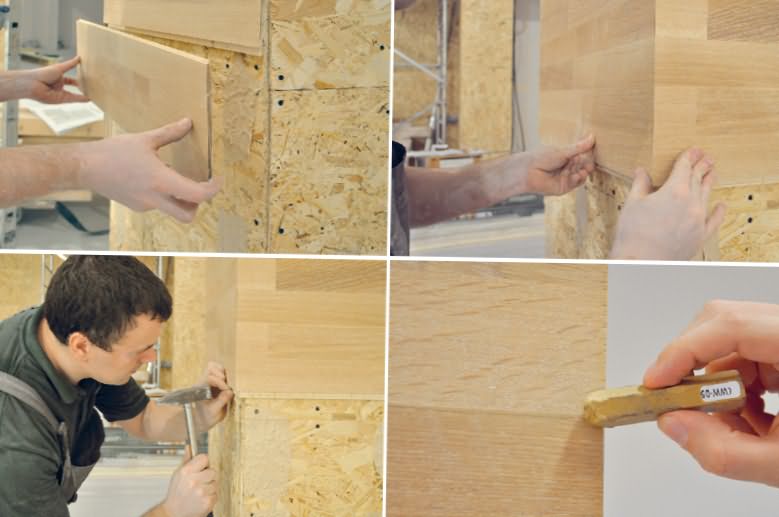
Sheets of wood materials are also actively used for wall and roof insulation houses from the inside. Both soft and hard boards can be used. A frame made of wooden slats is preliminarily stuffed onto the walls, then soft plates are nailed to act as insulation, and then hard ones, which will protect the layer of insulation from steam penetration.
Particleboard and fiberboard are versatile materials used for cladding roofs, walls and floors, making partitions and all kinds of structures. It is difficult to imagine the construction and decoration of a private house without the use of wood sheets. It is convenient and easy to work with them, and the result never disappoints.
These sheet products have gained popularity in the private sector largely due to the fact that they lend themselves well to processing, and their installation is not difficult. Plus - the rather low cost of the product, which makes it affordable for a wide range of buyers. But whether fiberboard and particleboard are the same in application, and if not, then what are the differences, not everyone understands. Hence, there is often disappointment, since their use in construction or repairs without taking into account the specific features will not give the desired result.
The main and essential difference between particleboard and fiberboard is in the specifics of their manufacture. Moreover, the difference is not in the technology itself, but in the raw materials that are used in production. The misconception that these are just varieties of one material is due to the fact that wood is partially present (in one form or another) at the base of each sample. But that's where the similarities end.
Differences between chipboard and fiberboard
Chipboard is made from low-value wood shavings. Synthetic resins are additional materials. Fiberboard is made from wood dust and cellulose fibers. Additional materials - synthetic polymers, rosin and paraffin; - fiberboard thickness from 2.5 to 12 mm, chipboard thickness can be up to 25 mm; - fiberboard is more resistant to moisture, and particleboard can withstand heavy loads; - chipboard prices are much higher, than on fiberboard; - Chipboard is used for laying floors and in the manufacture of furniture - structural elements; The scope of use of fiberboard is the production of furniture elements - boxes, shelves, shelves, the construction of partitions; - the service life of particleboard is much less than fiberboard.
Due to the steady decline in the stock of industrial wood, the production of all kinds of materials made from sawmill and wood processing waste is becoming more relevant than ever. It is to this group that fiberboard and chipboard belong, without the use of which neither the furniture industry, nor construction, nor many other industries (machine and shipbuilding, container production, etc.) can do.
Consumers often confuse these materials, although their production, appearance, and functional properties differ. What is the difference?
Production technology
The raw material for the production of fiberboard is the waste of the woodworking industry: wood chips, sawdust, fire (lignified parts of the stems of spinning plants). The raw material is washed, foreign inclusions are removed from it, then dried. The dried material is crushed in special machines (defibrators and refiners) into the smallest particles - fibers. Grinding can range from coarse to finest.Further, the process is different for different production methods.
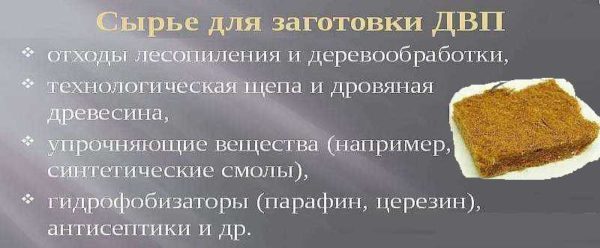
Raw material for the production of fiberboard
Pressing is carried out under high pressure - 3-5 MPa and high temperature - above 300 ° C. Due to this, the bonding and compaction of the material occurs. Before pressing, additional components are added to the starting material that change the properties of the material - binders (synthetic resins), water repellents, flame retardants, etc.
Forming methods
There are two ways to produce fiberboard - wet and dry pressing. The "wet" method is more environmentally friendly. In wet pressing, a smaller amount of binders is used (sometimes, without synthetic additives at all), but the material is more expensive, since the process is more energy intensive. It takes up to 15 minutes to dry one sheet, which limits the productivity of the presses, and therefore increases the cost of the material. With this method, the necessary additives, water, are introduced into the crushed material. The slurry enters the dispenser, which spreads it in an even layer on the belt. For faster removal of water, the tape has a mesh structure. After passing through the press, the back side of such fiberboard has an imprint of this fine mesh.
In wet pressing, some types of fiberboard can be made without the addition of an external binder. Under pressure and at high temperatures, lignin (a substance that characterizes the stiff walls of plant cells) is released from wood fibers. It is a natural binder. Lignin is found in significant quantities in softwood. But not for all types of fiberboard, a natural binder is sufficient. In this case, 4 to 7% of a synthetic binder is added.
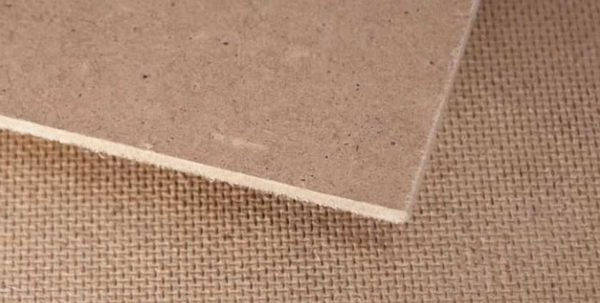
The type of molding is easily distinguished by the back of the board
When dry pressing, synthetic resins are usually added to the mass, which bind the fibers. It is this method that makes it possible to obtain fiberboard of a large thickness - up to 12-15 mm, some plants can produce pits with a thickness of up to 40 mm. The compaction and pressing of the dry mass takes much less time - 3-5 minutes, depending on the class and thickness. The productivity of the press increases significantly. In addition, fewer additives are added to the dry mass - they are not washed out with water. All this leads to a decrease in the cost of the material. But cheap binders contain formaldehyde, and its content must be controlled, since in large quantities it is harmful to health.
For the production of furniture and interior decoration, material with formaldehyde emission class E0.5 or E1 must be used. This is, as a rule, wet-pressed fiberboard. Wet fiberboard can be distinguished by the mesh print on the back of the sheet (see photo above).
Final processes
During high-temperature pressing, the particles stick together. The time spent under the press is not always enough, therefore the already formed sheets are transferred to a special chamber, where the material "ripens" at high temperatures. Fiberboard is kept here for several hours. During this time, the fibers are sintered, stick together, the material becomes homogeneous and durable.
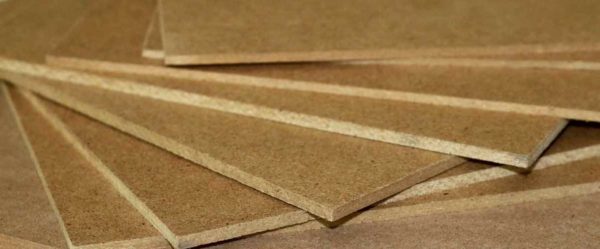
Fiber boards have different thicknesses
The slabs leave the chamber with practically zero humidity and begin to actively absorb moisture from the air. As a result of this process, the edges of the sheets swell. To avoid this disadvantage, the material is transferred to another chamber, where it is brought to normal moisture content. And only after that, the sheet fiberboard can go on sale or to other machines - for painting, lamination.
The good thing is that the fiberboard technology is plastic. The press can have any shape, which allows you to make not only sheet material, but also shaped products. For example, skirting boards or furniture fronts.
Density, weight, thickness of sheets
The technology for the production of fiberboard allows you to make them of different densities.Depending on the density, they have different technical characteristics and field of application. There are such types of fiberboard:
- Low density. They are also called soft, they can be designated using the attached letter "M" - DVP-M. Quite loose material with a density of 200-350 kg / m³. Sheet thickness can be 8, 12, 16, 25 mm. If desired, you can find up to 40 mm. They are usually used for soundproofing or as finishing / cladding in places that are not subject to stress.
Low density fiberboard has a loose structure, is used as insulation and sound insulation - Medium density - up to 850 kg / m³, sheet thickness can be 8, 12, 16, 25 mm. According to the classification, they also pass as soft.
- Semi-solid - from 860 to 900 kg / m³, sheet thickness 6, 8, 12 mm.
- Hard (fiberboard T) - 950 kg / m³, sheet thickness 2.5, 3.2, 4.5 and 6 mm.
- Superhard (DVP-ST) - 960-1000 kg / m³, can be 2.5, 3.2, 4.5 and 6 mm thick.
Hard and superhard grades are used where resistance to mechanical stress is important. In household construction and decoration of houses / apartments, DVP-T is placed on the floor, they can sheathe the walls with them.
Types of hard slabs
For all that, general-purpose solid fiber boards are of several types - with different front and back sides. According to GOST, solid fibreboard has the following marking:
- T - hard slabs with a non-refined front surface. Often also called "technical" fiberboard. It is used for works in which appearance is not important.
- T-P - hard boards with a tinted face layer. This is the so-called hardboard. It is used in the furniture industry for rear panels in cabinets, tables, etc.
The choice of colors is wide - Т-С - hard boards with a top layer of finely dispersed wood pulp. One side of the sheet is the same color, but smooth, like varnished. It can be used for cladding frame buildings from the inside. Requires minimal finishing work. On such a surface, a rhinestone can be glued wallpaper, but it will be very inconvenient to remove them. But the putty on the smoothed surface lays down badly - it rolls down.
- T-SP - hard boards with a tinted front layer of finely ground wood pulp. It can be used as a finishing material.
Grades of solid fiberboard can be of two classes - A and B. They are distinguished by quality. As you can see, even in the same class there are different materials. With the same (or almost the same) technical characteristics, they have different areas of application.
Subtypes of superhard fiber boards
Superhard fiber boards are rarely used in household construction and repair - the price is too high, and high density and stiffness may not be in demand. Excessive rigidity can sometimes be uncomfortable.
According to the standard, there are two types of such material:
- ST - "construction" brand, not too attractive in appearance;
-
ST-S - with a smooth top layer - finely ground wood pulp is compacted to a very smooth state.
Dense and smooth slabs
There are practically no laminated or decorative types - material that is too heavy and tough for finishing is also not needed.
Names by density
Also, fibreboards have different names depending on the density. Usually it is a tracing (transliteration) of English / international names. Although, under the same name, other countries often mean different material.
- LDF - from English low density fiberboard - LDF. Translated - low density fiberboard. In fact, this is what is called a medium density material, simply having characteristics at the lower boundary of the zone. It has nothing to do with soft wood boards.
MDF characteristics - MDF - from the English medium density fiberboard - MDF. Translated - medium density fiberboard. If we talk about standards, then this material corresponds to the GOST definitions of medium density fiberboard.
- HDF - hight density fiberboard - HDF.According to the characteristics, it is possible to match the brand of DVP-T (solid).
HDF boards are usually thin and are used for milling patterns
As you can see, there is no clear distinction. Misuse of the names adds to the confusion. In general, each time it is necessary to clarify what exactly the speaker means by this or that term.
What's the best material?
This question is somewhat incorrect, since in fact it is like comparing warm with soft. Each type of material is best used for its own purposes.
Chipboard is perfect for:
- execution of interior partitions;
- wall insulation from the inside;
- arrangement of the subfloor;
- furniture production.
In the latter case, hardboard will also come in handy, because the back walls of the cabinets and all kinds of drawers are made from this material. All kinds of wall surfaces are trimmed with fiber boards, especially in country houses, on balconies and in garages, because they are much less afraid of moisture than thick particle boards. Hardboard is also suitable as a substrate for the floor or an insulating layer on the ceiling, and real virtuosos of the construction business will easily turn its sheets into an elegant interior arch or a patterned door.
Many materials are used in the repair and construction of residential buildings, but some of them have covered themselves with simply unfading glory. Take fiberboard, for example. What it is?
The name stands for "fiberboard". This is a sheet material, the production of which takes place by pressing wood chips with the addition of various kinds of binding components.
As a rule, synthetic polymer resins are used in the latter incarnation. In addition, they include various substances that impart hydrophobic properties to the finished material.
Ceresin and paraffin are the cheapest (and therefore more commonly used). Antiseptic additives are often added to the composition. Because of them, mold practically does not grow on fiberboard. What it is? Most often, phenols act as such an antiseptic additive, which successfully prevent the development of fungi and destroy their spores.
They are produced in two ways: dry and wet. However, intermediate methods have recently appeared: wet-dry and semi-dry.
The cheapest method is the dry method, when fiberboard (what is it, we have already said) is formed from wood chips under normal conditions and without wetting it with water. The plate is pressed at high temperature and pressure.
The resulting material is notable for its low cost, significant porosity and lightness. Its humidity is only 6-8%.
The wet method consists of the same steps, but the wood shavings are sent for pressing, being moistened with water. After exiting the bale chamber, the material is cut into separate sheets and sent to the dryer. Such fiberboard panels have a moisture content already within 70%. That is why they are distinguished by their greater weight, but more durable.
The semi-dry method is similar to the first method described above. The only difference is that before being fed for pressing, the chips are sprinkled with water, so that the moisture content of the resulting material is 16-18%.
The wet-dry method differs from all of the above in that, first, a plate is formed from the shavings soaked in water, then it is fed to the drying unit and only after that it is sent to the hot pressing procedure. The result is fiberboard plywood, which is actually 0%.
Note that we are not acting entirely correctly when we speak of “shavings”. The fact is that these shavings are first ground into fibers with the help of special machines, from which the web of finished panels is already formed.
In recent years, refined fiberboard has been used much more often. In the manufacture of such panels, a multilayer coating is applied to their surface. At the first stage, the slab is covered with a special layer of primer, which creates a solid base.A drawing is printed on it, imitating the usual surface of a tree.
Such a plate is practically not afraid of moisture, as well as abrasion. In this case, a special varnish is used to harden the surface.
So we told you about fiberboard. You now know what it is. Due to the cheapness and strength of this material, it is often used not only in the furniture industry, but also in the construction industry.
Differences between hardboard and fiberboard
In fact, hardboard is the name for hard and superhard fiberboard grades. In accordance with the current GOSTs, the specification and description of hardboard fully corresponds to hard fiberboard brands with an index T. Some authors argue that hardboard differs from fiberboard in its composition and production characteristics. Indeed, during its production, rosin, paraffin, various antiseptics and other materials are added to the feedstock, contributing to a significant improvement in operational characteristics. However, in the production of special grades of fiberboard, they are also used.
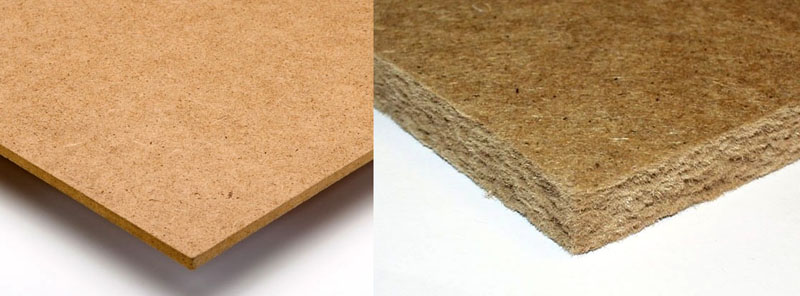 The difference in density between soft fiberboard and hardboard can be assessed visually
The difference in density between soft fiberboard and hardboard can be assessed visually
Related article:
Application area
The scope of use of the products is quite wide:
- Manufacturing of furniture backdrops and drawer bottoms. Colored fragments of decorative variations allow you to hide sections of walls, slides, living rooms or cabinets for the kitchen, bathroom.
- As a facing material. Sheets are mounted on walls and ceilings, creating a flat surface for further work. It is taken into account that it is rather difficult to glue tiles or wallpaper to such a base; preparatory measures are carried out for this. The parts are also suitable for laying on the floor as a substrate. But if necessary, hardboard can be used independently as a finishing coating.
- Sewing interior doors of economy class. The slab is placed on a lightweight cellular base, which ensures a low weight of the structure.
- Decoration of the interior space of cars, wagons, as well as the creation of protective packaging and padding during the transportation of various items.
Compared to fiberboard, hardboard has a narrower scope of use related to hard plates.
Where is it applied?
Fiberboard sheets are used in various fields.
Construction
Here this material is used as sound and heat insulation, surface leveling, decorative coating. The following areas are especially highlighted:
- For wall decoration. Fiberboard is used to level the wall surface under the topcoat. Plates smooth out all the unevenness of brick or block masonry, a wooden frame. On such a surface, you can then glue wallpaper or decorate by painting and whitewashing.
- For finishing floors. Leveling of rough wood flooring or concrete screed is done with 5-8 mm thick sheets of solid type. On top of the fiberboard, you can safely lay parquet, lay linoleum or laminate. At the same time, the slabs play the role of sound insulation.
- For ceilings. With the help of fiberboard, wooden ceilings are leveled, and after installation, it is possible to whitewash without plastering. This material also gained popularity in the manufacture of a suspended ceiling.
We recommend: Mineral wool insulation - dimensions, which is better, characteristics. What and how is insulated with mineral wool
Manufacturing of furniture and doors
In cabinet furniture (cabinets, bedside tables), the back walls are most often made of fiberboard, which is facilitated by low cost, sufficient strength and durability. Sheets are used to make the bottoms of drawers, armchairs, sofas.
Almost everyone is familiar with panel doors, which are used as interior and entrance doors. The wooden frame of such products is sheathed with fiberboard sheets. The surface is painted or varnished. Decorative (laminated) options do not require coating at all.

Manufacturing of containers
Boxes of different sizes are made by sheathing the wooden frame with fiberboard sheets.Such containers are highly durable and cheap.
Fiberboard is used for finishing the interiors of various vehicles.
In addition to using ordinary fiberboard, it should be remembered that special products are also produced that can be safely used with increased moisture, in sports and medical institutions, increased fire safety requirements etc.
What kind of material?
Fiberboard, or abbreviated fiberboard, is a pressed sheet material in which the wood fibers are bonded with a special filler. Sometimes the term fiberboard is used, which combines different types of wood fiber materials.
The history of its origin begins in 1858, when a patent was issued to Lyman for a prototype of a modern slab. Since then, the material and its manufacturing technology have been constantly improved. Hot pressing of wood fiber boards allowed Münch to improve them significantly, but so far they were made without a binder.
Mass production began after 1924, when Mason developed wet pressing technology in the United States. This is how high density fiberboard called "Masonite" appeared. Already in the 30s of the 20th century, he conquered Europe and began to be actively used in construction as insulation and finishing material.
Features of fiberboard are associated with the technology of its manufacture. We use sawmill and woodworking waste, various wood chips and plant fires, which are turned into wood fibers by defibrators as raw materials.
The filler is synthetic resins, added in an amount of 5-9%, and to improve the properties, water repellents (rosin, ceresin, paraffin), antiseptics and fire retardants are added. The mixture is laid out in the form of a carpet and hot pressed.
Ultimately, depending on the composition, fiberboard can have a density in a wide range from 200 to 1100 kg / m³. After drying, the residual moisture content of the material does not exceed 11-12%. Low thermal conductivity (from 0.045 to 0.09 W / mhgrad) allows it to be used as a heater.
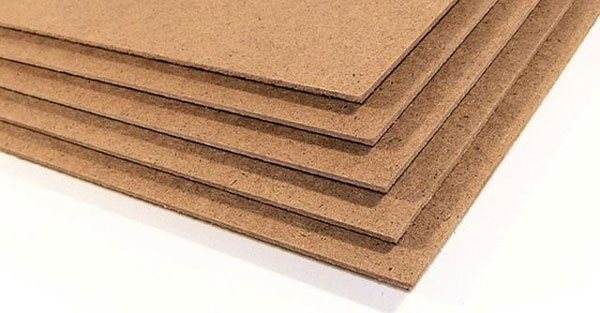
Advantages and disadvantages
The following advantages of fiberboard can be distinguished:
- sufficiently high strength;
- ecological cleanliness;
- no deformation from aging;
- moisture resistance;
- ease of processing;
- the possibility of reliable fastening using conventional fasteners (nails, screws);
- the ability to apply almost any protective or decorative coatings.
Plates do not swell even after prolonged exposure to water and can be operated at humidity above 60%. The main advantage of the material is its low cost.
We recommend: Foam insulation for use in the construction of private houses. Composition, types and characteristics of foam
The disadvantages are mainly related to the impossibility of making slabs of great thickness. For technological reasons, it does not exceed 10-12 mm, which somewhat limits the scope of use. Accordingly, it is impossible to ensure the high strength of the panels, despite the fact that the specific strength of the material is rather high.
Chipboard
The abbreviation stands for "chipboard
". This material is the result of pressing a raw mass consisting of shavings, sawdust mixed with resin (usually formaldehyde). Moreover, in the process of squeezing the mixture, it is exposed to significant thermal effects.
Material features
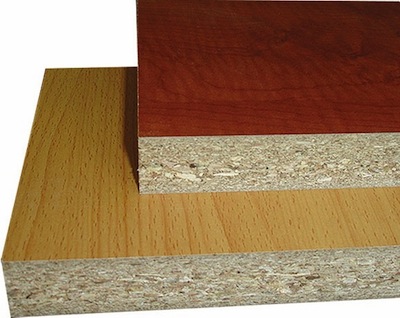 Such plates are thicker than fiberboard (up to 50 mm), which allows them to withstand high mechanical loads. In everyday life, they are most often used for the installation of "dry" screeds, reinforcement of vertically oriented surfaces (with an obligatory "backing"), as a basis in various designs. Cheap furniture is made of them, partitions, shelves, awnings, fences and the like are equipped.
Such plates are thicker than fiberboard (up to 50 mm), which allows them to withstand high mechanical loads. In everyday life, they are most often used for the installation of "dry" screeds, reinforcement of vertically oriented surfaces (with an obligatory "backing"), as a basis in various designs. Cheap furniture is made of them, partitions, shelves, awnings, fences and the like are equipped.
The main disadvantage is a somewhat "loose" structure. This makes it difficult to bond the slabs to each other or to other structural elements.The self-tapping screw in the material "sits" not firmly. That is why it is not recommended to use it in the manufacture of temporary prefabricated / collapsible structures. Frequent dismantling / assembly leads to damage to the areas where the fasteners are placed, since the base begins to crumble in these places.
In addition, such boards need a systematic surface treatment (for example, varnish), as they absorb moisture well. They are not recommended for use outside buildings, in the open air or in rooms characterized by dampness.
The "rigidity" of the samples does not allow, if necessary, to achieve even a slight bending. Any attempt will lead to the formation of a crack, which somewhat limits the use of chipboard.
When buying slabs, you should inquire about their structure. The best examples are three-layer ones.
Fiberboard - what is it?
How did it all begin? It is worth noting that before the advent of wood composites, the yield of solid wood products at best was only 40%, the remaining 60% of the wood went to waste. Today, the amount of waste is only 10-12%, largely due to the emergence of composite materials, the basis of which is wood waste from the main production. It is not for nothing that the Germans are considered a thrifty nation, it was in Germany, in the 1930s, that particleboard appeared - chipboard, more often it is called particleboard.
It was based on waste from production: wood chips and shavings impregnated with phenolic resins. The first samples of composites were rather fragile, had a number of drawbacks, in addition, they were somewhat poisonous, since the binder, based on phenolic resins, released harmful substances into the atmosphere. Today we managed to get rid of these problems. Modern composites are durable, moisture resistant and absolutely harmless to humans: either chipboard or fiberboard. This also applies to all materials based on them.
 OSB, chipboard and other composites
OSB, chipboard and other composites
Not everyone knows what features the fiberboard material has. What kind of raw material is it, how it is produced and where it is used, we will try to find out further.
Fiberboard is a sheet material made by hot pressing a wood fiber base impregnated with binder resins. It is used in construction, in the decoration of residential premises, in the manufacture of furniture and in industrial production. The field of application of composite materials based on wood fiber is wide, and it cannot be covered in one article. Fiberboard is found in any modern room, it can be a sheet laid on the floor as a substrate for a laminate, wall decoration for summer cottages and the back walls of cabinets in your apartment.
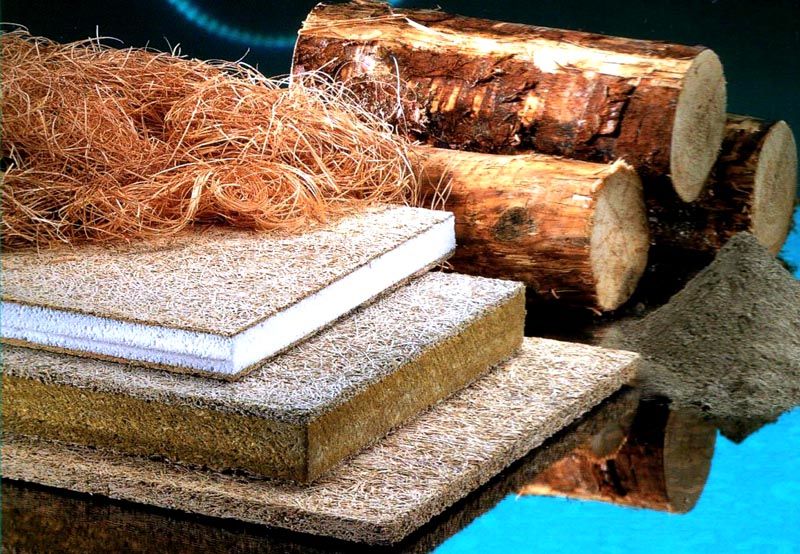 Wood fiber
Wood fiber

